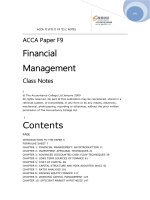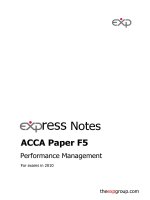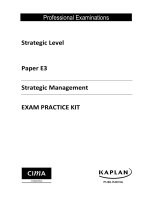ACCA paper p3 risk management
Bạn đang xem bản rút gọn của tài liệu. Xem và tải ngay bản đầy đủ của tài liệu tại đây (233.74 KB, 14 trang )
Professional Examinations
Strategic Level
Subject P3
Risk Management
EXAM PRACTICE KIT
SUBJECT P3 : R ISK MANA GEMEN T
Published by: Kaplan Publishing UK
Unit 2 The Business Centre, Molly Millars Lane, Wokingham, Berkshire RG41 2QZ
Copyright © 2017 Kaplan Financial Limited. All rights reserved.
No part of this publication may be reproduced, stored in a retrieval system or transmitted in any
form or by any means electronic, mechanical, photocopying, recording or otherwise without the
prior written permission of the publisher.
Notice
The text in this material and any others made available by any Kaplan Group company does not
amount to advice on a particular matter and should not be taken as such. No reliance should be
placed on the content as the basis for any investment or other decision or in connection with any
advice given to third parties. Please consult your appropriate professional adviser as necessary.
Kaplan Publishing Limited and all other Kaplan group companies expressly disclaim all liability to
any person in respect of any losses or other claims, whether direct, indirect, incidental,
consequential or otherwise arising in relation to the use of such materials.
British Library Cataloguing in Publication Data
A catalogue record for this book is available from the British Library
ISBN: 978-1-78415-937-5
Printed and bound in Great Britain
P.2
CONTENTS
Page
Index to questions and answers
P.4
Examination Techniques
P.5
Syllabus Guidance, Learning Objectives and Verbs
P.7
Approach to revision
P.11
Section
1
Objective test questions
1
2
Answers to Objective test questions
81
Quality and accuracy are of the utmost importance to us so if you spot an error in any of our
products, please send an email to with full details.
Our Quality Co-ordinator will work with our technical team to verify the error and take action to
ensure it is corrected in future editions.
P.3
INDEX TO QUESTIONS AND ANSWERS
OBJECTIVE TEST QUESTIONS
Page number
Question
Answer
1 – 45
Identification, classification and evaluation of risk
1
81
46 – 99
Responses to strategic risk
14
87
100 – 148 Internal controls to manage risk
33
96
149 – 203 Managing risks associated with cash flows
50
104
204 – 256 Managing risks associated with capital investment
decisions
63
115
P.4
EXAM TECHNIQUES
COMPUTER-BASED ASSESSMENT
TEN GOLDEN RULES
1
Make sure you have completed the compulsory 15 minute tutorial before you start exam.
This tutorial is available through the CIMA website. You cannot speak to the invigilator once
you have started.
2
These exam practice kits give you plenty of exam style questions to practise so make sure
you use them to fully prepare.
3
Attempt all questions, there is no negative marking.
4
Double check your answer before you put in the final answer although you can change your
response as many times as you like.
5
On multiple choice questions (MCQs), there is only one correct answer.
6
Not all questions will be MCQs – you may have to fill in missing words or figures.
7
Identify the easy questions first and get some points on the board to build up your
confidence.
8
Try and allow 15 minutes at the end to check your answers and make any corrections.
9
If you don't know the answer, flag the question and attempt it later. In your final review
before the end of the exam try a process of elimination.
10
Work out your answer on the whiteboard provided first if it is easier for you. There is also
an onscreen ‘scratch pad’ on which you can make notes. You are not allowed to take pens,
pencils, rulers, pencil cases, phones, paper or notes.
P.5
SUBJECT P3 : R ISK MANA GEMEN T
P.6
SYLLABUS GUIDANCE, LEARNING
OBJECTIVES AND VERBS
A AIMS OF THE SYLLABUS
The aims of the syllabus are
•
•
•
to provide for the Institute, together with the practical experience requirements, an
adequate basis for assuring society that those admitted to membership are competent to
act as management accountants for entities, whether in manufacturing, commercial or
service organisations, in the public or private sectors of the economy;
to enable the Institute to examine whether prospective members have an adequate
knowledge, understanding and mastery of the stated body of knowledge and skills;
to complement the Institute's practical experience and skills development requirements.
B STUDY WEIGHTINGS
A percentage weighting is shown against each topic in the syllabus. This is intended as a guide to
the proportion of study time each topic requires.
All component learning outcomes will be tested and one question may cover more than one
component learning outcome.
The weightings do not specify the number of marks that will be allocated to topics in the
examination.
C LEARNING OUTCOMES
Each topic within the syllabus contains a list of learning outcomes, which should be read in
conjunction with the knowledge content for the syllabus. A learning outcome has two main
purposes:
1
to define the skill or ability that a well-prepared candidate should be able to exhibit in the
examination;
2
to demonstrate the approach likely to be taken by examiners in examination questions.
The learning outcomes are part of a hierarchy of learning objectives. The verbs used at the
beginning of each learning outcome relate to a specific learning objective, e.g. Evaluate
alternative approaches to budgeting.
The verb 'evaluate' indicates a high-level learning objective. As learning objectives are
hierarchical, it is expected that at this level students will have knowledge of different budgeting
systems and methodologies and be able to apply them.
A list of the learning objectives and the verbs that appear in the syllabus learning outcomes and
examinations follows and these will help you to understand the depth and breadth required for a
topic and the skill level the topic relates to.
P.7
SUBJECT P3 : R ISK MANA GEMEN T
Learning objectives
1 Knowledge
What you are expected
to know
Verbs used
Definition
List
State
Make a list of
Express, fully or clearly, the details of/
facts of
Give the exact meaning of
Define
2
Comprehension
What you are expected
to understand
Describe
Distinguish
Explain
Identify
Illustrate
3
Application
How you are expected
to apply your
knowledge
Apply
Calculate/compute
To put to practical use
To ascertain or reckon mathematically
Demonstrate
Solve
Tabulate
To prove with certainty or to exhibit by
practical means
To make or get ready for use
To make or prove consistent/
compatible
Find an answer to
Arrange in a table
Analyse
Categorise
Examine in detail the structure of
Place into a defined class or division
Compare and contrast
Produce
Show the similarities and/or differences
between
To build up or compile
To examine in detail by argument
To translate into intelligible or familiar
terms
To create or bring into existence
Advise
Evaluate
Recommend
Advise
To counsel, inform or notify
To appraise or assess the value of
To advise on a course of action
To counsel, inform or notify
Prepare
Reconcile
4
Analysis
How you are expected
to analyse the detail of
what you have learned
Construct
Discuss
Interpret
5
P.8
Evaluation
How you are expected
to use your learning to
evaluate, make
decisions or
recommendations
Communicate the key features of
Highlight the differences between
Make clear or intelligible/State the
meaning of
Recognise, establish or select after
consideration
Use an example to describe or explain
something
S YLLABUS GUID ANCE , LEAR NING OBJE CTIV ES AND VER BS
D OBJECTIVE TEST
The most common types of Objective Test questions are:
•
•
multiple choice, where you have to choose the correct answer from a list of four possible
answers. This could either be numbers or text.
multiple choice with more choices and answers – for example, choosing two correct
answers from a list of eight possible answers. This could either be numbers or text.
single numeric entry, where you give your numeric answer e.g. profit is $10,000.
multiple entry, where you give several numeric answers e.g. the charge for electricity is
$2000 and the accrual is $200.
true/false questions, where you state whether a statement is true or false e.g. external
auditors report to the directors is FALSE.
matching pairs of text e.g. the convention 'prudence' would be matched with the
statement' inventories revalued at the lower of cost and net realisable value'.
other types could be matching text with graphs and labelling graphs/diagrams.
•
In this Exam Practice Kit we have used these types of questions.
•
•
•
•
•
Some further guidance from CIMA on number entry questions is as follows:
•
•
•
•
•
For number entry questions, you do not need to include currency symbols or other
characters or symbols such as the percentage sign, as these will have been completed for
you. You may use the decimal point but must not use any other characters when entering
an answer (except numbers) so, for example, $10,500.80 would be input as 10500.80
When expressing a decimal, for example a probability or correlation coefficient, you should
include the leading zero (i.e. you should input 0.5 not .5)
Negative numbers should be input using the minus sign, for example –1000
You will receive an error message if you try to enter a character or symbol that is not
permitted (for example a ‘£’ or ‘%’ sign)
A small range of answers will normally be accepted, taking into account sensible rounding
Guidance re CIMA On-Screen calculator:
As part of the computer based assessment software, candidates are now provided with a
calculator, although they can also use a physical calculator. This calculator is on-screen and is
available for the duration of the assessment. The calculator is accessed by clicking the calculator
button in the top left hand corner of the screen at any time during the assessment.
All candidates must complete a 15 minute tutorial before the assessment begins and will have the
opportunity to familiarise themselves with the calculator and practise using it.
Candidates may practise using the calculator by downloading and installing the practice exam at
The calculator can be accessed from the fourth sample question
(of 12).
Please note that the practice exam and tutorial provided by Pearson VUE at
is not specific to CIMA and includes the full range of question types
the Pearson VUE software supports, some of which CIMA does not currently use.
The Objective Tests are ninety minute computer-based assessments comprising 60 compulsory
questions, with one or more parts. CIMA is continuously developing the question styles within the
system and you are advised to try the online website demo at www.cimaglobal.com, to both gain
familiarity with assessment software and examine the latest style of questions being used.
P.9
SUBJECT P3 : R ISK MANA GEMEN T
P.10
Section 1
OBJECTIVE TEST QUESTIONS
IDENTIFICATION, CLASSIFICATION AND EVALUATION OF RISK
A1: TYPES OF RISK
1
2
Which one of the following sentences best describes risk?
A
The exposure to the adverse consequences of dangerous environments
B
The expected impact of uncertain future events on objectives
C
The chance of being caught doing something unethical
D
The impact of the exposure to the adverse consequences of uncertain future events
Risk management is the process of reducing the adverse consequences either by reducing
the _____________ of an event or its _________.
What are the two missing words?
3
4
A
Understanding and impact
B
Likelihood and potential
C
Understanding and potential
D
Likelihood and impact
Risk appetite is determined by
A
Risk attitude and risk awareness
B
Risk attitude and risk capacity
C
Risk strategy and risk awareness
D
Risk attitude and residual risk
The four strategies in TARA for managing risk do NOT include which one of the following?
A
Transference
B
Approval
C
Avoidance
D
Acceptance
1
S UB J E CT P3 : RI SK M ANA GEMEN T
5
Risks can be categorised as either ‘pure’, ‘speculative’ or ‘upside’. Drag and drop the
following risks into the correct category.
Pure
risks
Speculative
risks
The risk that a fire may destroy company assets
The risk that a customer goes out of business
The risk that a foreign exchange rate may change
The risk relating to the level of future profits
The risk that a capital investment may not yield the
predicted IRR
The risk that a virus is introduced to a computer
application
6
There are six steps in CIMA’s risk management cycle. Identify the correct sequence of
steps, by entering step numbers below.
Development of risk response strategy
Implement strategy and allocate responsibilities
Review and refine process and do it again
Identify risk areas
Implementation and monitoring of controls
Understand and assess scale of risk
7
Match each of the following risks to the appropriate risk category.
Risk category
Business risks
Economic risks
Environmental risks
Financial risks
8
Match each of the following risks to the appropriate risk category.
Risk category
Business risks
Economic risks
Corporate reputation risks
Political risks
9
Risk
CEO convicted of insider dealing
Disposable income levels fall
Nationalisation of industry
Raw material prices rise
Match each of the following risks to the appropriate risk category.
Risk category
Political risks
Legal risks
Regulatory risks
Compliance risks
2
Risk
Inflation rate rises
Exchange rate changes
Failure of a new product
Rate of climate change increases
Risk
Government increases rate of Corporation Tax
Company prosecuted for breach of the Data
Protection Act
Change of Government
Customer sues company for negligence
OBJE CTIVE TEST QUESTIONS : SECTION 1
10
11
X is a food manufacturer. X uses genetically modified (GM) ingredients in some of its
products. A change in public opinion regarding GM foods represents which of the
following types of risk? (One only)
A
Business risk
B
Economic risk
C
Reputation risk
D
Environmental risk
AA plc is a multinational company, retailing household electrical appliances. The finance
director is concerned about the lack of risk management as at the present time AA plc only
look at financial risk.
Select THREE of the following risk categories that would also be relevant for AA plc to
assess:
12
A
Gearing
B
Product risk
C
Reputation risk
D
Risk response
E
Technological risk
F
Monitoring Risk
Viva plc is a large casino company, operating all over the world. Each casino is a multimillion pound construction project. Viva plc’s current policy is to finance expansion using
high debt levels.
Which THREE of the following risks would you identify as critical for Viva to assess?
A
Financial risk
B
Project risk
C
Foreign Exchange rate risk
D
Production risk
E
Health and safety risk
F
commodity price risk
3
S UB J E CT P3 : RI SK M ANA GEMEN T
13
OKJ is currently undertaking a risk analysis.
Which TWO of the following factors are the most important risk issues facing OKJ?
14
A
OKJ’s home country has recently elected a new government. It is not yet clear if they
will introduce new legislation to increase minimum wages. This would have a major
impact on OKJ’s profitability.
B
After a recent accident in one of its factories, OKJ was convicted of breaching
relevant health and safety legislation. Based on similar recent cases brought in the
industry, OKJ expects to be fined around 7% of its turnover. OKJ has insurance in
place that will cover this fine.
C
OKJ uses platinum as a key component within some of its products. The price of
metals varies significantly on world markets and tends to rise sharply in times of
recession. The directors are concerned that its products may become unprofitable if
platinum prices rise more than 20% from their current levels, but is uncertain about
whether this would happen – even if a recession does occur.
D
OKJ is uncertain about whether it can retain its CEO in the long term. It has had a
number of CEO’s over the last five years – each of them staying very different lengths
of time in their roles. Fortunately, OKJ has an experienced Board of Directors and the
change in CEOs has had little impact on the business in the past.
One of the first steps in developing a risk management strategy is to determine the risk
capacity, attitude and appetite of the organisation. Match the definitions with the terms
below:
Term
risk capacity
risk attitude
risk appetite
15
16
Definition
‘the overall approach to risk’
‘the amount of risk that the organisation is willing to accept in the
pursuit of value added’
‘the amount of risk that the organisation is able to bear’
The Board of X is discussing risk. The first item for discussion is the organisation’s ‘risk
appetite’. Which of the following factors determine the risk appetite of an organisation?
Select all that apply.
A
The background of the board
B
The number of directors
C
The reputation of X
D
The nature of the product or service of X
E
Customer expectations
The identification of risk is an important stage in developing a risk management strategy.
Approaches to identifying risk are categorised as internal or external, and proactive or
reactive.
The use of SWOT and PEST(EL) analysis are both examples of which approach?
4
A
internal proactive
B
internal reactive
C
external proactive
D
external reactive









